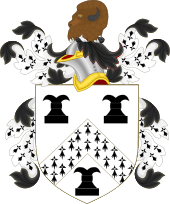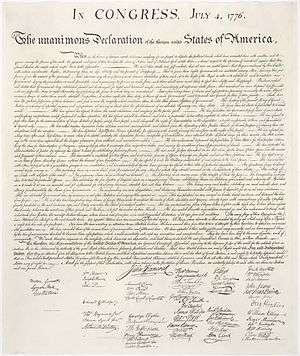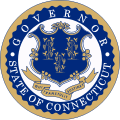Oliver Wolcott
Oliver Wolcott Sr. (November 20, 1726 – December 1, 1797) was an American politician. He was a signer of the United States Declaration of Independence and also of the Articles of Confederation as a representative of Connecticut and the nineteenth Governor of Connecticut. He was a major general for the Connecticut Militia in the Revolutionary War serving under George Washington.[1]
Oliver Wolcott Sr. | |
|---|---|
 | |
| 19th Governor of Connecticut | |
| In office January 5, 1796 – December 1, 1797 | |
| Lieutenant | Jonathan Trumbull Jr. |
| Preceded by | Samuel Huntington |
| Succeeded by | Jonathan Trumbull Jr. |
| 23rd Lieutenant Governor of Connecticut | |
| In office 1786–1796 | |
| Governor | Samuel Huntington |
| Preceded by | Samuel Huntington |
| Succeeded by | Jonathan Trumbull Jr. |
| Personal details | |
| Born | Oliver Wolcott November 20, 1726 Windsor, Connecticut |
| Died | December 1, 1797 (aged 71) Litchfield, Connecticut |
| Resting place | East Cemetery, Litchfield, Connecticut |
| Political party | Federalist |
| Spouse(s) | Laura Collins Wolcott |
| Children | 5, including Oliver Wolcott Jr. |
| Parents | Roger Wolcott Sarah Drake Wolcott |
| Profession | Militia Officer, Politician |
| Signature | |
Early life

Wolcott was born in Windsor, Connecticut, the youngest of 14 children born to colonial governor Roger Wolcott and Sarah Drake Wolcott. He attended Yale College, graduating in 1747 as the top scholar in his class.[2] Upon graduation, New York governor George Clinton granted Wolcott a captain's commission to raise a militia company to fight in the French and Indian War. Captain Wolcott served on the northern frontier defending the Canadian border against the French until the Treaty of Aix-la-Chapelle. At the end of the war, he moved to newly settled Goshen in northwestern Connecticut to practice and study medicine with his brother Alexander.[3] He then moved to Litchfield and became a merchant; he was appointed sheriff of the newly created Litchfield County, Connecticut, serving from 1751 to 1771. He married Lorraine (Laura) Collins of Guilford, Connecticut on January 21, 1755.[4] Their children were: Oliver (who died young), Oliver, Jr., Laura, Mariann, and Frederick.
Career
.jpg)
Revolutionary War Years
Wolcott had two careers during the war years as one of Connecticut's principal delegates to the Continental Congress and also a militia officer.[5] He participated in the American Revolutionary War as brigadier general and then as major general in the Connecticut militia. As a representative in the Continental Congress, he was a strong advocate for independence.
Early in the growing struggle with Great Britain, Wolcott made it clear that the colonists would not give up their rights and privileges.[6] In February 1776, he stated: "Our difference with Great Britain has become very great. What matters will issue in, I cannot say, but perhaps in a total disseverance from Great Britain."[7] This early support for independence led him to important roles during the war, both as military leader and as member of the Continental Congress.
Wolcott saw extensive militia service during the American Revolution. On August 11, 1776, Connecticut officials ordered him to march the Seventeenth Regiment of militia to New York and join George Washington's army. Upon arriving at Washington's camp, Connecticut Governor Jonathan Trumbull appointed Wolcott brigadier general in command of all the state's militia regiments in New York. He led 300—400 volunteers from his brigade to help General Horatio Gates and Benedict Arnold defeat Burgoyne at the Battle of Saratoga.[8]
In May 1779, Wolcott was promoted to major general in command of all Connecticut Militia.[9] That summer, he saw combat in protecting the coastline from Tryon's raids.[10] He was largely unsuccessful in his combat with Major General William Tryon. Over the course of the war, he showed great disdain towards his opposition, describing the British in his memoirs as "a foe who have not only insulted every principle which governs civilized nations but by their barbarities offered the grossest indignities to human nature."[11]
The Continental Congress appointed him Commissioner of Indian Affairs, and he was elected to the Congress in 1775. He became seriously ill in 1776 and did not sign the Declaration of Independence until some time later.
Post Revolutionary War
At the beginning of the Revolution, Congress had made Wolcott a commissioner of Indian affairs to persuade the northern Indian nations to remain neutral. His qualifications for this role came from his early experience on the northern front of the French and Indian War. Now he was asked along with Richard Butler and Arthur Lee, to negotiate a peace treaty with the Six Nations at Fort Schuyler.[10]
Beyond his post-war diplomatic role, Wolcott aspired to higher office. He was elected Lieutenant Governor of Connecticut as a Federalist in 1786, and served in this position for ten years. He was reelected to the position, holding the office until his death at the age of seventy-one.[12]
Death and legacy
Wolcott died on December 1, 1797, in Litchfield, Connecticut.[1][13][14] He is interred at East Cemetery, in Litchfield, Connecticut. Historian Ellsworth Grant remembers Wolcott's Revolutionary war efforts in stating that, "It is doubful if any other official in Connecticut during this period carried so many public duties on his shoulders."[10]

Oliver Wolcott Jr., his son, served as Secretary of the Treasury under Presidents George Washington and John Adams and as Governor of Connecticut. The town of Wolcott, Connecticut bears his name.[15] His home in Litchfield was declared a National Historic Landmark in 1971. In Torrington, Connecticut there is a school named after him, The Oliver Wolcott Technical High School.
In 1798, Fort Washington on Goat Island in Newport, Rhode Island was renamed Fort Wolcott. Fort Wolcott was an active fortification until 1836. It later became the site of the United States Naval Torpedo Station.
His descendants include Congregationalist minister Samuel Wolcott, D.D.; Edward O. Wolcott a United States Senator from Denver; and Anna Wolcott Vaile,[16] who established the Wolcott School for Girls in Denver.[17]
References
-

- Ellsworth S. Grant, "From Governor to Governor in Three Generations," The Connecticut Historical Society Bulletin, Volume 39 no.3, Hartford, July 1974, 65—66.
- Bruce Stark, "Signers of the Declaration of Independence, State Governors"," American National Biography Online, 1.
- Stark, "Signers of the Declaration of Independence, State Governors," American National Biography Online, 1.
- Stark, Signers of the Declaration of Independence, State Governors, American National Biography Online, 1.
- Grant, "From Governor to Governor in Three Generations," 68.
- Edmund C. Burnett, ed., "Letters of Members of the Continental Congress," vols. 1—3, 5—7 (8 vols., 1921—1936), vol. 1, 163.
- Grant, "From Governor to Governor in Three Generations," 68—69.
- Stark, "Signers of the Delectation of Independence," 1.
- Grant, "From Governor to Governor in Three Generations," 69.
- Wolcott Papers, vol.1, (Connecticut Historical Society, Hartford, Connecticut), 240.
- "Oliver Wolcott". National Governors Association. Retrieved 24 November 2012.
- "Oliver Wolcott". Encyclopedia Britannica. Retrieved 3 June 2019.
- "Wolcott, Oliver (1726-1797), Connecticut governor and revolutionary patriot | American National Biography". American National Biography. doi:10.1093/anb/9780198606697.001.0001/anb-9780198606697-e-0101003. Retrieved 3 June 2019.
- The Connecticut Magazine: An Illustrated Monthly. Connecticut Magazine Company. 1903. p. 335.
- "The Wolcott Family". The National Magazine: (Cleveland) a Monthly Journal of American History. Magazine of Western History Publishing Company. 1889. p. 627–629.
- James Bretz (2010). Denver's Early Architecture. Arcadia Publishing. p. 114. ISBN 978-0-7385-8046-3.
Bibliography
- "A Guide to the Oliver Wolcott, Sr. Papers, from 1638-1834." Connecticut Historical Society, 2016.
- Grant, Ellsworth. "From Governor to Governor In Three Generations," (The Connecticut Historical Society Bulletin, Volume 39 no.3, Hartford, July 1974), 65—77". Cite journal requires
|journal=(help) - Jensen, Merrill (1978). The Documentary History of the Ratification of the Constitution: Volume III Ratification of the Constitution by the States Delaware, New Jersey, Georgia and Connecticut. Madison: State Historical Society of Wisconsin.
- Mahoney, Patrick. "Soldier, Patriot, and Politician: The Life of Oliver Wolcott". Connecticut History.org. CThumanities. Retrieved 30 November 2016.
- Stark, Bruce. "Oliver Wolcott". American National Biography Online.
External links
| Wikimedia Commons has media related to Oliver Wolcott. |
- American National Biography Online, Oliver Wolcott.
- Biography by Rev. Charles A. Goodrich, 1856
- Litchfield Historical Society
- National Governors Association
- The Political Graveyard
- The Peter Force Library at the Library of Congress has an important compilations of pamphlets that were assembled by Oliver Wolcott.
| Party political offices | ||
|---|---|---|
| Preceded by Samuel Huntington |
Federalist nominee for Governor of Connecticut 1796, 1797 |
Succeeded by Jonathan Trumbull Jr. |
| Political offices | ||
| Preceded by Samuel Huntington |
Lieutenant Governor of Connecticut 1786—1796 |
Succeeded by Jonathan Trumbull Jr. |
| Preceded by Samuel Huntington |
Governor of Connecticut 1796—1797 |
Succeeded by Jonathan Trumbull Jr. |

